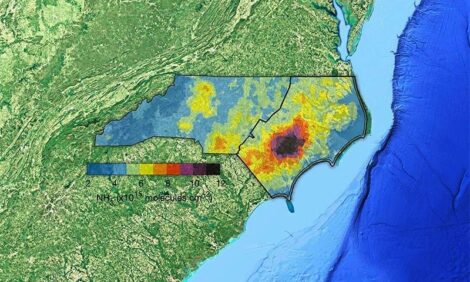



Prediction of Pork Prices & Production
By Ron Plain, published by Alberta Pork in their Banff Pork Seminar 2003. Change is a reality in today's hog industry and in this article, the first in a series from the 2003 Banff Pork Seminars, Ron Plain asks - How can Canadian pork producers shape that change to benefit themselves?
 In the last 6 years U.S. hog prices have stayed between $8/cwt and $68/cwt and there is a good chance they will trade within this same range most of the time in the next 6 years.
In the last 6 years U.S. hog prices have stayed between $8/cwt and $68/cwt and there is a good chance they will trade within this same range most of the time in the next 6 years.
This was Ron Plain's prediction. He also said economists can make a pretty good forecast of the past. It is obviously pretty hard to accurately predict prices, but we can definitely see some trends. These trends can give us an idea of whether prices are tending to rise or fall on any given year.
World Meat Trade
Pork is the world's most important meat. If the European Union (EU) is lumped together then Canada is number 5 in the world as far as production is concerned.
Meat trade is growing fast. In the last 5 years:
- World pork production is up 13.5%
- World pork trade is up 26.5%
| % change from 1996 | ||
| China | 42,200 | 34.3% |
| EU | 17,600 | 7.4% |
| USA | 8,691 | 11.9% |
| Brazil | 2,216 | 38.5% |
| Canada | 1,720 | 40.1% |
| Poland | 1,550 | -8.0% |
The top 6 importing countries are Japan, Russia, U.S.A, Mexico, Hong Kong and South Korea, with Japan being the largest at about 1100 metric tonnes in 2001.
The top exporting countries in 2001 are the E.U., Canada, U.S.A, Brazil, China and Hungary.
Of these top exporting countries, Canada is the most vulnerable. The E.U. and U.S.A. eat most of their own meat while Canada exports about 42% of their pork, with Hungary next at about 25.5%. Canada is vulnerable because of disease or anything else that could disrupt our ability to export. For example, a foot and mouth outbreak would be an absolute disaster because we are so dependent on exports.
The U.S. Pork Industry
Because the price we are paid for hogs is directly tied to the price of hogs in the U.S. it is very important that we understand trends in the U.S.. For example, graph #1 illustrates U.S. production from 1930 to 2001. As the graph shows there is a steady increase in production of about 1.5% per year for the last 70 years. There is no reason to believe this will not continue. This 1.5% per year trend is driven by population growth and exports. Actual per capita pork consumption has not changed since 1955 and is at 48 pounds. We can conclude that the American pork industry could support a constant 1.5% growth and it would have little affect on prices.

The problem is that there are significant differences from one year to the next, which means the hog cycle is still well and alive. In those years after 1964 when pork production was below the 1.5% trend, Iowa hog producers averaged a profit of $16.48 per hog sold. In those years after 1964 when pork production was above the 1.5% trend, Iowa hog producers averaged a net loss of $0.22 per hog sold.
Historically, changes in U.S. slaughter have lagged behind profitability by about 15 months. Sustained profit leads to production increase, which leads to oversupply (remember only 1.5% growth is sustainable) which leads to lower prices and the cycle continues. Profits in both 1996 and 1997 led to 9.9% more hogs in 1998. Profits in 1990 and 1991 led to 7.6% more hogs in 1992. But hog slaughter in 2002 was only up a bit over 2% after two profitable years in 2000 and 2001.
Ron Plain indicated three reasons for this lack of growth in 2002.
- The memory of the disasters in 1998 and 1999 had an affect on lenders and producers.
- Producers are aware of the limited packing capacity and how vulnerable they are.
- It is getting harder to get permits to build new operations.
All indications are that a reduction in inventory in 2002 will also lead to fewer hogs in 2003 and better prices.
Productivity
Another big factor affecting the amount of pork that is available, and therefore also prices, is the huge increase in productivity of pork producers. There are three factors that have had a huge affect on the increase in pork meat on the market:
- Pigs per litter
- Litters per sow
- Carcass weight
| 1960 | 2000 | |
| Pigs per litter | 7 | 8.8 |
| Litters per sow per year | 1.6 | 2.1 |
| Average hot carcass weight | 145 lbs | 195 lbs |
You add all this together and get a total growth of 4% per year from the same sow base. Graph #2 illustrates this very well. In 1960 the average sow produced about 1400 lbs of pork; in 2000 the average sow produced about 3600 lbs of pork, or 3 times the 1960 level. This is huge.

Farmer's Share of the Consumer Pork Dollar
Since 1960 there has also been a huge change in how each dollar that a consumer spends on pork gets divided up. at one point in September 2002, the farmer's share of the pork dollar dropped to its lowest level ever at less than 20%.
The following table indicates the split between farmer, packer and retailer for each dollar a consumer spends on pork:
| 1960 | 2000 | |
| Farmers share | 62% | 30% |
| Packers share | 22% | 13% |
| Processing, Distribution Retail share | 16% | 57% |
Combining Canada and U.S. Data
Canada's pork production has been increasing steadily over the last 6 years. Many of these pigs are being exported to the U.S.A. as weaner pigs and finished in the U.S. Therefore Canada's pork production industry has a large affect on the U.S. industry and therefore on the price of hogs. Graph 3 combines sows farrowed in the U.S. and Canada. You can see how this graph illustrates the hog cycle.
The graph shows that in January 2002 we already started to see a drop in farrowings. Daily sow slaughter started to increase a lot starting in May of 2002 and we peaked in about September before dropping slightly. We also had a large decrease in gilt retention starting in May of 2002. This meant the sow herd was not sustainable starting in May of 2002 and there was a net loss in sows.

Real Prices and Deflated Prices
Graph 4 shows what the terminal price of barrows and gilts was, going back to 1950. From 1950 to 1970 the price of hogs was very stable. Then in the early 70's there was a huge rise till it reached a new level at about 46 dollars per hundred weight. The main reason for this rise was the huge rates of inflation we had in the mid to late 70's. This trend lasted till about 1998 when we dropped to a new level of about 40$ per hundred weight. The reason for this new lower level is the increase in productivity we have seen in the last few years.

If we plot the same the same graph using 1967 dollars we get a totally different picture (see graph 5). Since 1982, inflation has caused a steady downward trend in the real value of the hog. If this trend continues, by 2011 we will have to pay the packer to take our hogs.
Forecast for 2003
Graphs 6 and 7 show Ron Plain's predictions for 2003 and beyond. It looks like 2003 will be better than 2002 as far as price is concerned.



Summary of the Good News
- Pork exports are strong
- Domestic demand is up
- Productivity growth is slowing
- Sow and gilt slaughter are both up
- USDA breeding inventory is down
- Slaughter weights are down
- More kill capacity than we thought








